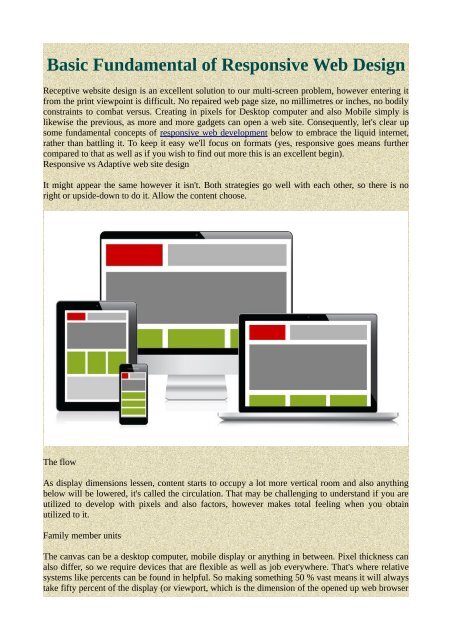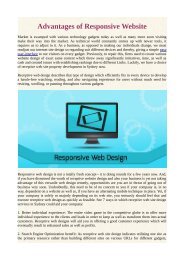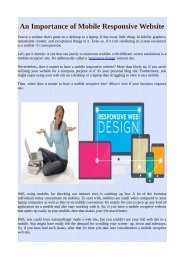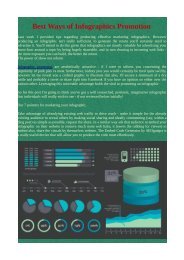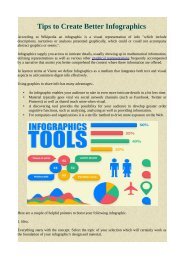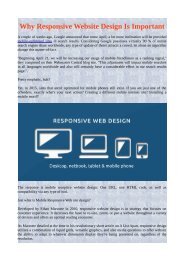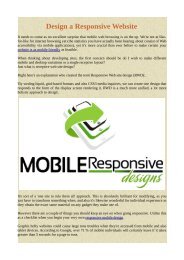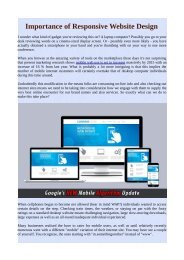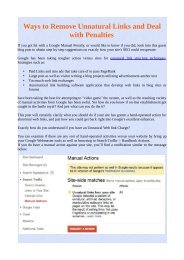Basic Fundamental of Responsive Web Design
Receptive website design is an excellent solution to our multi-screen problem, however entering it from the print viewpoint is difficult.
Receptive website design is an excellent solution to our multi-screen problem, however entering it from the print viewpoint is difficult.
You also want an ePaper? Increase the reach of your titles
YUMPU automatically turns print PDFs into web optimized ePapers that Google loves.
<strong>Basic</strong> <strong>Fundamental</strong> <strong>of</strong> <strong>Responsive</strong> <strong>Web</strong> <strong>Design</strong><br />
Receptive website design is an excellent solution to our multi-screen problem, however entering it<br />
from the print viewpoint is difficult. No repaired web page size, no millimetres or inches, no bodily<br />
constraints to combat versus. Creating in pixels for Desktop computer and also Mobile simply is<br />
likewise the previous, as more and more gadgets can open a web site. Consequently, let's clear up<br />
some fundamental concepts <strong>of</strong> responsive web development below to embrace the liquid internet,<br />
rather than battling it. To keep it easy we'll focus on formats (yes, responsive goes means further<br />
compared to that as well as if you wish to find out more this is an excellent begin).<br />
<strong>Responsive</strong> vs Adaptive web site design<br />
It might appear the same however it isn't. Both strategies go well with each other, so there is no<br />
right or upside-down to do it. Allow the content choose.<br />
The flow<br />
As display dimensions lessen, content starts to occupy a lot more vertical room and also anything<br />
below will be lowered, it's called the circulation. That may be challenging to understand if you are<br />
utilized to develop with pixels and also factors, however makes total feeling when you obtain<br />
utilized to it.<br />
Family member units<br />
The canvas can be a desktop computer, mobile display or anything in between. Pixel thickness can<br />
also differ, so we require devices that are flexible as well as job everywhere. That's where relative<br />
systems like percents can be found in helpful. So making something 50 % vast means it will always<br />
take fifty percent <strong>of</strong> the display (or viewport, which is the dimension <strong>of</strong> the opened up web browser
window).<br />
Breakpoints<br />
Breakpoints allow the format to alter at predefined factors, i.e. having 3 columns on a desktop, yet<br />
simply 1 pillar on a mobile device. Many CSS properties could be transformed from one breakpoint<br />
to another. Generally where you put one depends upon the content. If a sentence breaks, you could<br />
need to bring in a breakpoint. But use them with caution-- it could acquire cluttered swiftly when<br />
it's challenging to understand just what is influencing exactly what.<br />
Max and Minutes worths<br />
Sometimes it's terrific that content takes up the whole size <strong>of</strong> a screen, like on a mobile device, yet<br />
having the very same content stretching to the whole width <strong>of</strong> your TELEVISION screen frequently<br />
earns less sense. This is why Min/Max values assist. For example having size <strong>of</strong> ONE HUNDRED<br />
% and also Max width <strong>of</strong> 1000px would suggest that material will certainly load the display,<br />
however don't go over 1000px.<br />
Nested items<br />
Remember the relative location? Having a lot <strong>of</strong> elements depending upon each other would be<br />
tough to handling, for that reason covering components in a container maintains it way a lot more<br />
reasonable, clean and tidy. This is where static systems like pixels can aid. They work for content<br />
that you don't wish to scale, like logos and buttons.<br />
Mobile or Desktop first<br />
Technically there isn't really much <strong>of</strong> a difference if a project is begun with a high street display to a<br />
larger (mobile initial) or vice versa (desktop computer very first). Yet it adds additional limitations<br />
and aids you make decisions if you begin with mobile first. Typically individuals begin with both<br />
ends simultaneously, so actually, go and see what works better for you.
<strong>Web</strong>fonts vs System font styles<br />
Wan na have an awesome looking Futura or Didot on your site? Use webfonts! Although they will<br />
certainly look magnificent, remember that each will be downloaded and the more you'll have, the<br />
longer it will require to load the web page. System typefaces on the various other hand are lightning<br />
fast, except when the customer doesn't have it in your area, it will drop back to a default font.<br />
Bitmap pictures vs Vectors<br />
Does your symbol have lot <strong>of</strong> specifics as well as some fancy effects applied? If yes, utilize a<br />
bitmap. If not, consider using a vector photo. For bitmaps make use <strong>of</strong> a jpg, png or a gif, for<br />
vectors the most effective selection would be a SVG or an icon font. Each has some advantages and<br />
some drawbacks. Nevertheless keep in mind the size-- no photos ought to browse the web without<br />
optimization. Vectors on the various other hand frequently are tiny, yet some older internet browsers<br />
won't assist it. Additionally, if it has great deals <strong>of</strong> contours, it might be heavier than a bitmap, so<br />
pick carefully.


